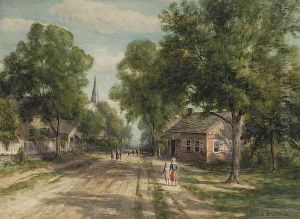Moses Jacob Ezekiel Paintings
Moses Jacob Ezekiel, born on October 28, 1844, in Richmond, Virginia, was a notable American sculptor of the 19th and early 20th centuries who achieved significant recognition in Europe, particularly in Italy where he spent the majority of his career. Coming from a Jewish family that had settled in the United States in the 18th century, Ezekiel's early life in the antebellum South would deeply influence both his personal ethos and his artistic output. He was a part of the first Jewish cadet class at the Virginia Military Institute (VMI), and his experiences during the Civil War, in which he fought for the Confederacy at the Battle of New Market, would later be reflected in some of his works. After the war, Ezekiel pursued his passion for art, initially studying at the Cincinnati Art Academy, and later, thanks to a scholarship, at the prestigious Royal Academy of Fine Arts in Berlin.
Ezekiel’s decision to move to Rome in 1873 marked the beginning of his most productive and successful period. Italy, with its rich artistic heritage and vibrant community of international artists, provided the ideal environment for his development. He set up his studio in the Baths of Diocletian, a setting that further inspired his work with its direct link to the classical past. Ezekiel was known for his technical skill, particularly in marble sculpture, and his ability to integrate classical themes with contemporary issues. His subjects ranged from religious figures and historical events to allegorical works and portraits, showcasing his versatility and depth as an artist.
Among his notable works are the statue of Religious Liberty in Philadelphia, the Confederate Memorial in Arlington National Cemetery, and the Thomas Jefferson statue at the University of Virginia. These pieces illustrate his commitment to themes of freedom, integrity, and the human spirit, ideals that he held dear throughout his life. Ezekiel was also a pioneer in representing Jewish themes in American art, as seen in his works such as the bust of Rabbi Isaac Mayer Wise and the poignant “Religious Liberty” statue. His contribution to art was recognized with numerous awards, including knighthood by the Italian government.
Moses Jacob Ezekiel died on March 27, 1917, in Rome, Italy, leaving behind a legacy that was as much about his remarkable sculptures as it was about breaking cultural and religious barriers in the art world. His works remain influential, celebrated for their technical mastery, emotional depth, and the complex interplay of his American roots and European training. Ezekiel’s life and art continue to be studied for their contribution to the narrative of American expatriate artists and the broader history of American art.
